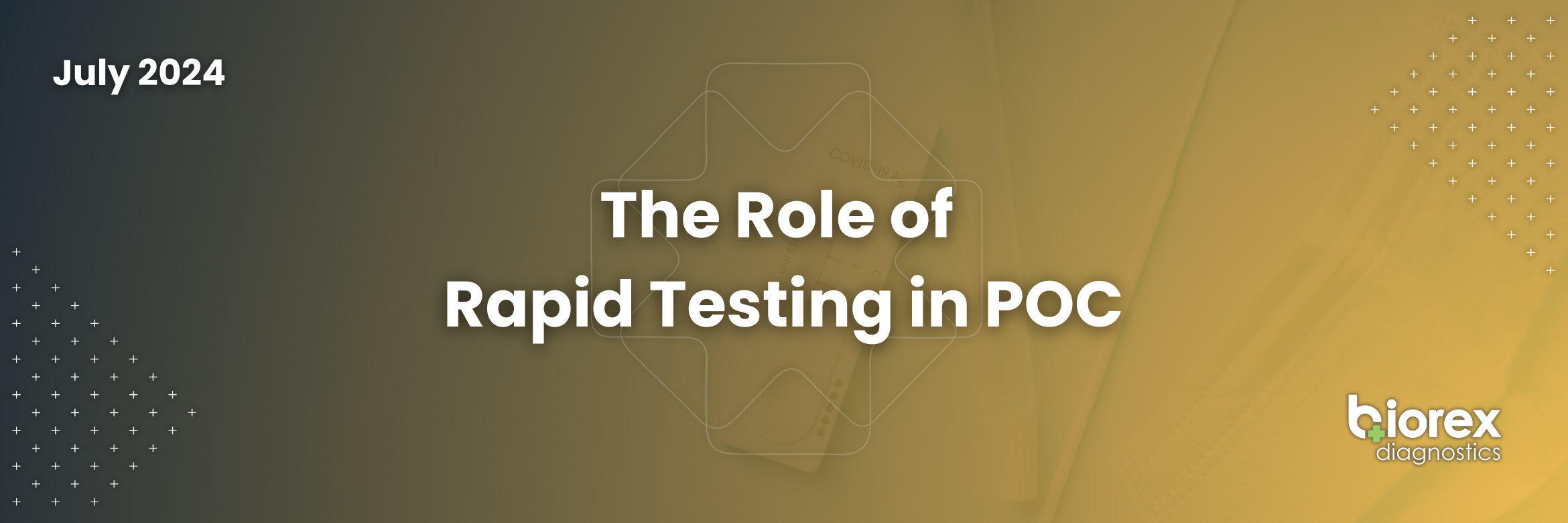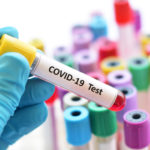
The Role of Rapid Testing in POC
Point-of-care (PoC) diagnostics have transformed the healthcare industry by bringing essential testing closer to patients and accelerating decision-making processes. Rapid testing is a crucial element of PoC diagnostics, providing swift results that enable timely interventions and enhance patient outcomes. This blog delves into the significance of rapid testing in PoC diagnostics, supported by relevant statistics and an analysis of its impact on healthcare delivery.
The Development of Point-of-Care Testing
Point-of-care testing (PoCT) involves medical diagnostic tests conducted at or near the site of patient care, contrasting with traditional laboratory testing that often requires sample transport to centralized labs, causing delays. PoCT aims to deliver immediate, actionable information to healthcare providers, facilitating prompt clinical decisions.
Historical Background
PoCT is not a new concept. Early bedside testing dates back to the 19th century when physicians used simple techniques like urinalysis and blood tests for disease diagnosis. The modern era of PoCT began in the 20th century with portable blood glucose meters for diabetes management. Technological advancements have since expanded PoCT to include tests for infectious diseases, cardiovascular markers, pregnancy, and more.
Technological Innovations
Recent advancements in biosensors, microfluidics, and lab-on-a-chip technologies have significantly enhanced PoCT devices’ capabilities and accuracy. These innovations have led to the widespread adoption of PoCT in various healthcare settings, including hospitals, clinics, pharmacies, and home care.
The Importance of Rapid Testing in PoC
Rapid testing is a fundamental component of PoCT, offering several benefits that improve healthcare delivery.
Speed and Efficiency
The most notable advantage of rapid testing is the quick availability of results. Traditional lab tests can take hours or days, whereas rapid tests can provide results in minutes. This speed is crucial in time-sensitive situations like emergency rooms, critical care units, and during infectious disease outbreaks.
Enhanced Patient Outcomes
Rapid PoC testing allows for quicker diagnosis and treatment, leading to better patient outcomes. For example, rapid diagnostic tests for diseases like influenza or COVID-19 enable early detection and isolation, reducing virus spread and allowing timely initiation of treatments.
Improved Workflow and Resource Utilization
Rapid PoC tests streamline clinical workflows and reduce the burden on centralized labs, leading to more efficient healthcare resource use, decreased patient wait times, and reduced overall healthcare costs.
Increased Access to Care
Rapid PoC testing enhances access to diagnostic services, particularly in remote or underserved areas where centralized labs are scarce. Portable and user-friendly PoC devices can be used in rural clinics, community health centers, and during field missions, ensuring timely and accurate diagnoses for more patients.
Statistics Demonstrating the Impact of Rapid PoC Testing
Understanding rapid PoC testing’s true impact requires examining statistics that highlight its effectiveness in various clinical scenarios.
Infectious Diseases
Rapid PoC tests have significantly advanced infectious disease diagnostics. During the COVID-19 pandemic, rapid antigen tests were crucial in controlling the virus’s spread. A study in the Journal of Clinical Microbiology found that COVID-19 rapid antigen tests had a sensitivity of about 80% and specificity of 97% compared to RT-PCR tests, with results available in 15-30 minutes, enabling quick isolation and treatment.
Diabetes Management
Rapid PoC testing has been vital in managing chronic conditions like diabetes. The International Diabetes Federation (IDF) reported 463 million adults with diabetes worldwide in 2019. Rapid blood glucose testing allows immediate monitoring and insulin therapy adjustments, reducing complications such as hypoglycemia or hyperglycemia. Studies show that regular use of PoC blood glucose meters improves glycemic control and reduces diabetes-related complications.
Cardiovascular Diseases
Cardiovascular diseases (CVD) are a leading cause of global morbidity and mortality. Rapid PoC tests for cardiac markers like troponin have transformed acute coronary syndrome (ACS) diagnosis. A study in the European Heart Journal found that high-sensitivity troponin PoC tests in emergency departments halved the time to diagnose myocardial infarction, enabling faster life-saving treatments.
HIV/AIDS
Rapid PoC tests for HIV have been transformative in the fight against HIV/AIDS. The World Health Organization (WHO) reported 38 million people living with HIV globally in 2019. Rapid HIV tests, providing results in under 30 minutes, have significantly increased HIV testing accessibility and uptake, especially in resource-limited settings. Early diagnosis through rapid testing allows timely initiation of antiretroviral therapy (ART), improving prognosis and quality of life for people living with HIV.
Challenges and Considerations
While rapid PoC testing offers many benefits, challenges and considerations must be addressed to maximize its potential.
Accuracy and Reliability
A primary concern with rapid PoC tests is their accuracy and reliability compared to traditional lab tests. Technological advancements have improved PoC device performance, but ensuring these tests meet stringent quality standards and provide accurate results is crucial. False positives or negatives can have significant clinical implications, leading to misdiagnosis or inappropriate treatment.
Training and Education
Successful rapid PoC testing implementation requires adequate healthcare provider training and education. Proper sample collection, handling, and result interpretation are essential for accurate and reliable PoC testing. Ongoing training programs and quality assurance measures are necessary to maintain high PoC testing standards.
Cost and Affordability
The cost of rapid PoC tests can hinder their widespread adoption, especially in low- and middle-income countries. While the initial investment in PoC devices may be high, the long-term benefits of improved patient outcomes and reduced healthcare costs can outweigh the initial expenses. Efforts should be made to make PoC tests affordable and accessible to all populations, regardless of socioeconomic status.
Regulatory and Quality Control
Regulatory frameworks and quality control measures are essential to ensure rapid PoC tests’ safety and efficacy. Regulatory bodies like the U.S. Food and Drug Administration (FDA) and the European Medicines Agency (EMA) play a crucial role in evaluating and approving PoC devices. Ongoing monitoring and post-market surveillance are necessary to identify and address any performance issues with PoC tests.
Future Directions
The future of rapid PoC testing is promising, with ongoing research and development focused on expanding available tests and improving their accuracy and reliability. Key areas of future development include:
Integration with Digital Health Technologies
Integrating rapid PoC tests with digital health technologies could further enhance their impact. Mobile applications and cloud-based platforms can facilitate remote monitoring and data sharing, enabling real-time decision-making and personalized healthcare. Digital health technologies can also support data analytics and artificial intelligence (AI) algorithms to improve PoC test result interpretation.
Multiplexed PoC Testing
Multiplexed PoC tests, which can simultaneously detect multiple analytes or pathogens from a single sample, are an emerging research area. These tests can provide comprehensive diagnostic information in a single assay, reducing the need for multiple tests and streamlining clinical workflows. For example, multiplexed PoC tests for respiratory infections can detect influenza, COVID-19, and other common respiratory pathogens simultaneously, offering a comprehensive diagnosis in a single test.
Point-of-Care Genomics
Advancements in genomics and molecular diagnostics are opening new possibilities for PoC testing. Point-of-care genomics involves using portable devices to perform genetic testing at or near the site of patient care. These tests can provide valuable information about an individual’s genetic predisposition to certain diseases, enabling personalized treatment and preventive strategies. Point-of-care genomics could revolutionize fields like oncology, infectious diseases, and pharmacogenomics.
Conclusion
Rapid testing is vital in point-of-care diagnostics, offering numerous benefits that improve healthcare delivery. By providing immediate and accurate results, rapid PoC tests enable timely clinical decisions, enhance patient outcomes, and improve healthcare system efficiency. While challenges like accuracy, training, cost, and regulatory considerations must be addressed, rapid PoC testing’s future is promising, with ongoing advancements and innovations poised to expand its impact further. As healthcare evolves, rapid PoC testing will remain a critical tool in the pursuit of better health outcomes for all.
How Biorex Can Help
Biorex supply over 40+ rapid tests including CK-MB, Multi-Drug Screen Test Dipcards, and HbsAg/HCV/HIV/Syphilis Combo Rapid Tests.
Explore the Biorex Rapid Test range here.







